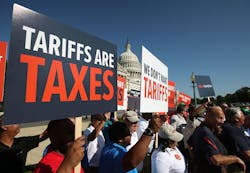The phrase “tit for tat” hardly seems serious enough to describe the current spiral toward a US-vs.-the-world trade war; yet nearly every report on tariffs throws it in. It sounds more like a grade-school squabble than a sound, forward-looking policy. But beyond the “you started it!” reflex, “tit for tat” is actually recognized as a winning strategy in game theory.
Specifically, it works in “the prisoner’s dilemma”—a simple but fundamental exercise in which two suspects in a crime can either cooperate with police and implicate the other, or remain silent. The greatest reward is to betray the other (or “defect”), the greatest penalty is levied when both suspects defect. The choice to cooperate, or for both to remain silent, imposes a much lesser penalty. The game is played a number of times and the results are totaled to determine the winner.
In short, a tit-for-tat strategy says to repeat the last move by your opponent. Soon enough, players learn to cooperate—the best long-term solution.
You’ll have to Google around for the finer points and why game theory is meaningful in reality, but experts with big brains spend careers on this kind of thing.
Of course, President Trump isn’t the first to try to use tariffs to address the unfair trade practices of other nations—but they rarely work. Protecting sick industries doesn’t make them competitive. And, essentially, a tariff is, somehow, meant to punish another nation by taxing our own. Tariffs remind me of the sheriff in the movie Blazing Saddles who holds himself hostage to escape an angry mob.
The good news is that businesses may appeal tariffs on materials that are critical and hard to source otherwise. And many companies have tried to do so, apparently: The USTR office is struggling to keep up with these requests.
To help its members make sense of the exclusion process, the National Association of Trailer Manufacturers (NATM), with the support of the government affairs representatives at K&L Gates, has broken down the 10-page guidance into some key points:
Exclusions will be made on a product basis. A particular exclusion will apply to all imports of the product, regardless of whether the importer filed a request.
If USTR grants a product exclusion, tariffs paid by the importers will be refunded retroactive to July 6, 2018. The exclusion will be effective for one year (through July 5, 2019).
The deadline for filing a product exclusion request is Oct. 9, 2018.
Interested parties must submit a separate request for each product. Each request must specifically identify a particular product, and provide supporting data and the rationale behind the requested exclusion.
Following public posting of the filed request on Regulations.gov, interested parties will have 14 days to file responses to the request for product exclusion. After the close of the 14-day response period, interested parties will have an additional seven days to reply to any responses received in support of or opposition to the request.
Similarly, the Truck Trailer Manufacturing Association emailed its members the product code specifics in an attempt to clear up their tariffs questions, characterizing the situation as “a moving swamp.”
For those keeping score, the current Harmonized Tariff Schedule (HTS) for aluminum and steel products can be found at https://hts.usitc.gov/current.
The Motor Equipment Manufacturers Association, meanwhile, still hopes to show the Trump administration the errors of its trading policy ways. As this edition of Trailer/Body Builders was going to press, MEMA again called on the president to find alternative means to get China to curb intellectual property (IP) theft.
“The current, continued and expected retaliatory tariffs could negate the Trump administration’s recent successful work on behalf of American companies, such as tax reform,” MEMA said in its latest statement. “The protection of intellectual property is a critical issue for MEMA and its members, and for decades MEMA has advocated for strong global protections of IP investments.
“However, MEMA fears that escalating this back-and-forth with a major trade partner will not resolve the issue at hand: intellectual property rights (IPR) protection is critical to the sustained success of the motor vehicle parts manufacturing industry, the largest sector of manufacturing jobs in the United States.”
MEMA supports stronger bi-lateral “engagement” where China and the US work together to protect IP, or leveraging the relationships the US holds with other trading partners to pressure China to comply with international IP laws.
Sounds like a winning strategy.
About the Author
Kevin Jones
Editor
Kevin has served as editor-in-chief of Trailer/Body Builders magazine since 2017—just the third editor in the magazine’s 60 years. He is also editorial director for Endeavor Business Media’s Commercial Vehicle group, which includes FleetOwner, Bulk Transporter, Refrigerated Transporter, American Trucker, and Fleet Maintenance magazines and websites.
Working from Beaufort, S.C., Kevin has covered trucking and manufacturing for nearly 20 years. His writing and commentary about the trucking industry and, previously, business and government, has been recognized with numerous state, regional, and national journalism awards.

